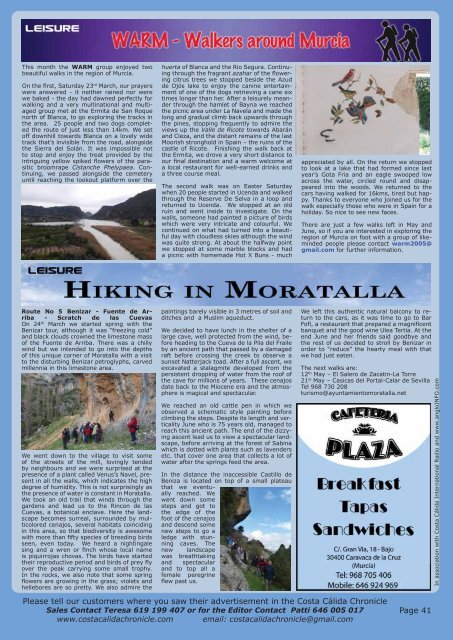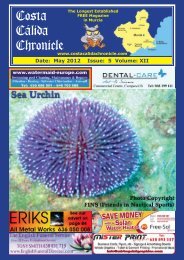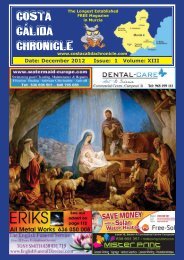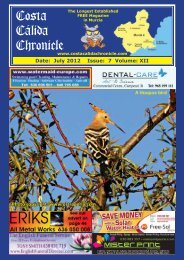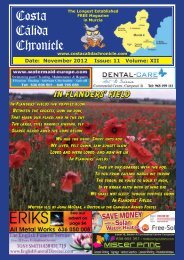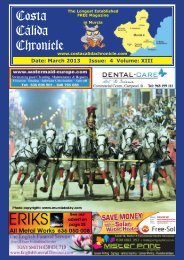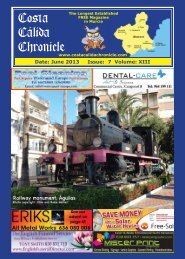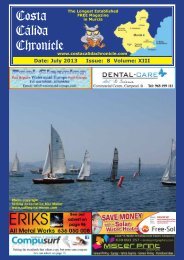May 2013 - Costa Calida Chronicle
May 2013 - Costa Calida Chronicle
May 2013 - Costa Calida Chronicle
Create successful ePaper yourself
Turn your PDF publications into a flip-book with our unique Google optimized e-Paper software.
This month the WARM group enjoyed two<br />
beautiful walks in the region of Murcia.<br />
On the first, Saturday 23 rd March, our prayers<br />
were answered - it neither rained nor were<br />
we baked - the day had dawned perfectly for<br />
walking and a very multinational and multiaged<br />
group met at the Ermita de San Roque<br />
north of Blanca, to go exploring the tracks in<br />
the area. 25 people and two dogs completed<br />
the route of just less than 14km. We set<br />
off downhill towards Blanca on a lovely wide<br />
track that’s invisible from the road, alongside<br />
the Sierra del Solán. It was impossible not<br />
to stop and enjoy the treat provided by the<br />
intriguing yellow spiked flowers of the parasitic<br />
broomrape Cistanche Phelypaea. Continuing,<br />
we passed alongside the cemetery<br />
until reaching the lookout platform over the<br />
huerta of Blanca and the Rio Segura. Continuing<br />
through the fragrant azahar of the flowering<br />
citrus trees we stopped beside the Azud<br />
de Ojós lake to enjoy the canine entertainment<br />
of one of the dogs retrieving a cane six<br />
times longer than her. After a leisurely meander<br />
through the hamlet of Bayna we reached<br />
the picnic area under La Navela and made the<br />
long and gradual climb back upwards through<br />
the pines, stopping frequently to admire the<br />
views up the Valle de Ricote towards Abarán<br />
and Cieza, and the distant remains of the last<br />
Moorish stronghold in Spain – the ruins of the<br />
castle of Ricote. Finishing the walk back at<br />
the Ermita, we drove a very short distance to<br />
our final destination and a warm welcome at<br />
a local restaurant for well-earned drinks and<br />
a three course meal.<br />
The second walk was on Easter Saturday<br />
when 20 people started in Ucenda and walked<br />
through the Reserve De Selva in a loop and<br />
returned to Ucenda. We stopped at an old<br />
ruin and went inside to investigate. On the<br />
walls, someone had painted a picture of birds<br />
which were very intricate and colourful. We<br />
continued on what had turned into a beautiful<br />
day with cloudless skies although the wind<br />
was quite strong. At about the halfway point<br />
we stopped at some marble blocks and had<br />
a picnic with homemade Hot X Buns - much<br />
appreciated by all. On the return we stopped<br />
to look at a lake that had formed since last<br />
year’s Gota Fria and an eagle swooped low<br />
across the water, circled round and disappeared<br />
into the woods. We returned to the<br />
cars having walked for 16kms, tired but happy.<br />
Thanks to everyone who joined us for the<br />
walk especially those who were in Spain for a<br />
holiday. So nice to see new faces.<br />
There are just a few walks left in <strong>May</strong> and<br />
June, so if you are interested in exploring the<br />
region of Murcia on foot with a group of likeminded<br />
people please contact warm2005@<br />
gmail.com for further information.<br />
Route No 5 Benizar - Fuente de Arriba<br />
- Scratch de las Cuevas<br />
On 24 th March we started spring with the<br />
Benizar tour, although it was “freezing cold”<br />
and black clouds crowned the limestone mass<br />
of the Fuente de Arriba. There was a chilly<br />
wind but we intended to go into the depths<br />
of this unique corner of Moratalla with a visit<br />
to the disturbing Benizar petroglyphs, carved<br />
millennia in this limestone area.<br />
We went down to the village to visit some<br />
of the streets of the mill, lovingly tended<br />
by neighbours and we were surprised at the<br />
presence of a plant called Venus’s Navel, present<br />
in all the walls, which indicates the high<br />
degree of humidity. This is not surprisingly as<br />
the presence of water is constant in Moratalla.<br />
We took an old trail that winds through the<br />
gardens and lead us to the Rincon de las<br />
Cuevas, a botanical enclave. Here the landscape<br />
becomes surreal, surrounded by multicolored<br />
cenajos, several habitats coinciding<br />
in this area, so that biodiversity is awesome<br />
with more than fifty species of breeding birds<br />
seen, even today. We heard a nightingale<br />
sing and a wren or finch whose local name<br />
is piquirrojas chovas. The birds have started<br />
their reproductive period and birds of prey fly<br />
over the peak carrying some small trophy.<br />
In the rocks, we also note that some spring<br />
flowers are growing in the grass; violets and<br />
hellebores are so pretty. We also admire the<br />
paintings barely visible in 3 metres of soil and<br />
ditches and a Muslim aqueduct.<br />
We decided to have lunch in the shelter of a<br />
large cave, well protected from the wind, before<br />
heading to the Cueva de la Pila del Fraile<br />
by an ancient path that passed by a damaged<br />
raft before crossing the creek to observe a<br />
sunset Natterjack toad. After a full ascent, we<br />
excavated a stalagmite developed from the<br />
persistent dropping of water from the roof of<br />
the cave for millions of years. These cenajos<br />
date back to the Miocene era and the atmosphere<br />
is magical and spectacular.<br />
We reached an old cattle pen in which we<br />
observed a schematic style painting before<br />
climbing the steps. Despite its length and verticality<br />
June who is 75 years old, managed to<br />
reach this ancient path. The end of the dizzying<br />
ascent lead us to view a spectacular landscape,<br />
before arriving at the forest of Sabina<br />
which is dotted with plants such as lavenders<br />
etc. that cover one area that collects a lot of<br />
water after the springs feed the area.<br />
In the distance the inaccessible Castillo de<br />
Beniza is located on top of a small plateau<br />
that we eventually<br />
reached. We<br />
went down some<br />
steps and got to<br />
the edge of the<br />
foot of the cenajos<br />
and descend some<br />
new steps to go a<br />
ledge with stunning<br />
caves. The<br />
new landscape<br />
was breathtaking<br />
and spectacular<br />
and to top all a<br />
female peregrine<br />
flew past us.<br />
We left this authentic natural balcony to return<br />
to the cars, as it was time to go to Bar<br />
Fofi, a restaurant that prepared a magnificent<br />
banquet and the good wine Ulea Tertia. At the<br />
end June and her friends said goodbye and<br />
the rest of us decided to stroll by Benizar in<br />
order to “reduce” the hearty meal with that<br />
we had just eaten.<br />
The next walks are:<br />
12 th <strong>May</strong> – El Salero de Zacatin-La Torre<br />
21 st <strong>May</strong> – Casicas del Portal-Calar de Sevilla<br />
Tel 968 730 208<br />
turismo@ayuntamientomoratalla.net<br />
In association with <strong>Costa</strong> Cálida International Radio and www.angloINFO.com<br />
Please tell our customers where you saw their advertisement in the <strong>Costa</strong> Cálida <strong>Chronicle</strong><br />
Sales Contact Teresa 619 199 407 or for the Editor Contact Patti 646 005 017<br />
www.costacalidachronicle.com email: costacalidachronicle@gmail.com<br />
Page 41


